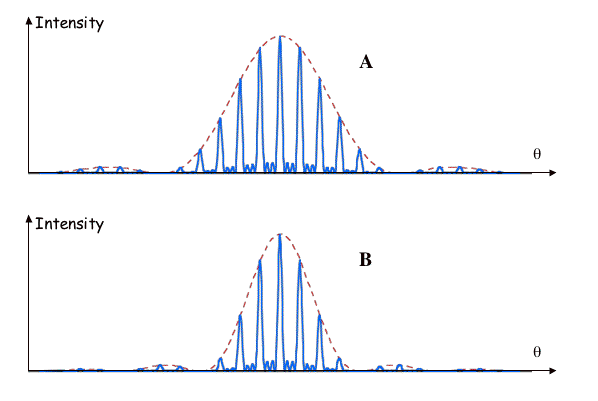Previous
•
Index
•
Next
2.1: Diffraction Limit
NOTE: λ=c/f
a. Half-Angle Width: θo=1.22*λ/D
θ=2*(1.22*λ/D)
b. [2π*Rc]/[θ*Rs] Rc=Radius from center of earth=42400 ; Rs=Radius from surface of earth=36000
c. θ=v/fD ... factorD = 1/factorf
2.2: Single Slit Diffraction
a. β=(2π*a*θ)/λ (with a=2λ) β=4π*θ
using sinθ=θ, plug in values to get β to determine the angle
b. I=Io[sin(β/2)/(β/2)]2
2.3: Missing Order
d=slit separation W=slit width L=distance to screen
Interference Maximum: sinθ=mλ/d for m=0,±1,±2 (m=0 is the central bright fringe)
Diffraction Minimum: sinθ=m'λ/W for m'=±1,±2,±3 (m'≠0 since the central fringe is a bright fringe, not a diffraction minimum)
first diffraction minimum at m'=1, so sinθ = m'λ/W = λ/W
interference maximum given by sinθ = mλ/d
therefore, mλ/d=λ/W :: m=d/W
2.4: Interference-Diffraction Pattern
a. N=2
b. a=λ/θ θ=angle to first zero
c. d=λ/θ θ=angle to first nonzero peak
d. I=I0[sin(β/2)/(β/2)]2 β=2πaθ/λ
2.5: Grating
a. 400 nm
b. 700 nm
c. 400 nm
d. 700 nm
e. (d*sinθ)/(4λ)
f. 2
g. 1
h. 1
NOTE ABOUT HOMEWORK B: THESE ANSWERS MAY NOT BE CORRECT. USE THEM AT YOUR OWN RISK.
HomeworkB 02
------------
1. A diffraction grating is W=1.00 cm wide and has N=8000 slits. A monochromatic light source of λ=660 nm shines through the grating onto a screen. At what angle does the first order line appear on the screen?
dsinθ=nλ (n=1 ; d=W/N)
2. Another source of light is present and is just barely resolved from the 660 nm source in the second order. What is the difference in wavelength between this source and the original source?
Δλmin=λ/Nm (m=2 ; λ=660nm)
3. If N is doubled, what happens to the minimum difference in wavelength that can be resolved for a given order?
N and Δλmin are inversely proportional, ∴ increasing N decreases Δλmin
4. Consider two muktiple-slit patterns: with number of slits NA and NB, slit widths aA and aB, wavelengths λA and λB, separations dA=dB

different slit widths aA≠aB because first diffraction minimums occur at different points.
5. Considering larger objects, a skyscraper has two tall antennae separated by 3 meters. Each antenna has one blue and one red light. You can resolve the two blue lights but not the red ones. Assume that your pupils have a diameter = 2 mm at night, and that blue light's wavelength is 475 nm, while red light's wavelength is 650 nm. Approximately how far are you from the skyscraper? (Also assume that you have 'perfect vision' limited only by diffraction.)

10km


